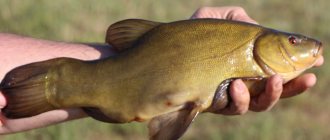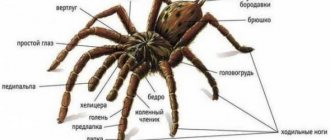Description
Externally, lampreys look like eels or large worms, but they are not one or the other. They have no scales and their body is covered with mucus. Therefore, many people consider lampreys to be worms. However, they are primitive vertebrates, united by zoologists into a separate class of cyclostomes. The following factors indicate their relationship to vertebrates:
- There is a flexible elastic rod that replaces the spine.
- A chain of miniature paired cartilages that provide protection to the spinal cord.
- A skeleton composed of cartilage and connective tissue designed to protect the brain.
The mouth has a complex system of cartilage that provides support for the oral funnel and tongue. Representatives of this group do not have real jaws, and the mouth is rounded and looks like a suction funnel. On its surface and powerful tongue there are horny teeth.
The photo shows that the head has three eyes (parietal and a pair of lateral ones) and seven gill slits on each side. Thanks to this feature, among the common people it received another name - seven-hole. There is one fin on the tail and another pair on the back. Lampreys are forced to spend most of their lives at the bottom of reservoirs, since they have neither a swim bladder nor paired fins. They are characterized by a nocturnal lifestyle. They prefer to swim alone, gathering in large groups during the spawning period.
Life expectancy is approximately 5-7 years.
Where does it live?
Lampreys prefer temperate latitudes. They can be found in the waters of the Southern Hemisphere, the Northern Hemisphere, and the waters of the Arctic Ocean. In Russia, it is found in large lakes and rivers. Of the approximately 40 species existing on the planet, the European part of Russia is inhabited by three:
- Marine - lives in the Caspian Sea basin.
- River - inhabits large rivers.
- Brook - found in small rivers and streams.
The river lamprey is much larger in size compared to the brook variety.
The habitat of lampreys is directly dependent on their life cycle. During the larval stage, they prefer bodies of water such as streams, rivers and lakes. At this stage, lampreys choose areas with a soft mud bottom to live in, making it easier to hide from predators. Adults of predatory species then move to open ocean waters, while non-predatory species remain in freshwater bodies.
Lifestyle
Passing form. Leads a hidden lifestyle. Previously, the Caspian lamprey ascended to the Volga from late September to mid-December. The move continues without interruption even during ice drift (V.M. Krapin). Saratov's peak season is from mid-December to mid-February. The move usually occurs at night. During the day, the lamprey lies motionless in the coldest places on the bottom, clinging to some object.
Danger to humans
Even from the photo you can see that you shouldn’t expect anything good from a relationship with a lamprey. There were several cases in Germany where she attacked a person.
- A 45-year-old man was attacked just offshore. He was able to free himself from it, so he did not receive serious wounds.
- But the 14-year-old was a little less lucky. Semidyr had already managed to attach himself well to his leg. Only in the hospital did medical workers manage to save the boy from this creature.
- A 60-year-old man swam away from the seashore to relax and “lie on the water.” Lying on his back, he suddenly felt a sharp pain and a bite in his back. From fright, the man almost sank to the bottom, but was able to feel some kind of slippery creature and, tearing it off his back, quickly swam to the shore. But it was impossible to avoid another bite (this time on the leg). The fishermen who came to the rescue argued that there was no need to take any measures, since the lamprey is not a poisonous creature.
However, medical professionals have a different opinion. Some danger to people still exists. Through the wound, substances secreted by the lamprey with the help of the cheek glands penetrate into the victim’s body. This leads to decreased blood clotting, destruction of red blood cells and tissue damage. It is recommended that even with a minor bite you seek medical help at a medical facility.
How to cook better
Lamprey is an important game fish and appears in a variety of recipes. It is fried and boiled, baked and pickled, canned. There are several popular cooking options.
Pickled lamprey
Marinated lamprey can not only be purchased in the store, but also prepared at home. The ingredients you will need are the following:
- lamprey - 1 kg;
- sugar - 2 tbsp. l.;
- water - 1 l;
- salt - 1 tbsp. l.;
- vinegar 6% - 100 ml;
- pepper - to taste;
- bay leaf - 3 pcs.;
- cloves - to taste.
The step-by-step algorithm for preparing the dish is as follows:
- Fresh lamprey is placed in a plastic bag, generously sprinkled with salt and put in the refrigerator for an hour.
- After time, the fish are removed and the carcasses are thoroughly wiped of mucus using paper towels.
- In a hot frying pan, fry the lamprey on both sides until golden brown, adding almost no oil.
- To prepare the marinade, sugar and salt are diluted in water, cloves, peppercorns and bay leaves are added.
- Place the solution on the stove, bring to a boil and simmer for five minutes.
- Add vinegar, stir and remove from heat.
Fried lampreys are poured with hot marinade, allowed to cool slightly and put in the refrigerator. After the solution with spices has hardened, the dish will be ready to eat.
It is necessary to marinate the lamprey with the addition of a small amount of oil in which the fish was fried
Grilled lamprey in jelly
Another recipe suggests cooking lamprey in spiced jelly using the oven. The ingredients needed are:
- fresh lamprey - 4 kg;
- coarse table salt - 2 kg;
- cloves - 10 pcs.;
- bay leaf - 4 pcs.;
- allspice peas - 6 pcs.;
- tea bags - 8 pcs.;
- gelatin - 3 tbsp. l.;
- black peppercorns - 8 pcs.
We recommend reading: Deer meat: composition, benefits and harm to the human body
The detailed algorithm for creating a dish is as follows:
- An hour before cooking, gelatin is poured with cold liquid and left to swell.
- Bring about 2.5 liters of water to a boil, add spices and salt to taste and leave on high heat for five minutes.
- Turn off the heat and immerse tea bags in the solution for 10-15 minutes, and then throw them away.
- Preheat the grill oven to 250°C.
- The carcasses are thoroughly wiped with salt and then washed under the tap.
- Cover a baking sheet with parchment paper in two layers and lay out the fish.
- Place the lamprey in the oven for 20-25 minutes until a golden brown crust forms.
- Remove the baking sheet and transfer the finished fish in rows into a deep bowl.
- Water the carcasses on top with the juice released during the frying process.
- Refill the tray with fresh fish and repeat the whole process until all 4 kg of fillets are used up.
- Pour gelatin into the solution with spices, bring to a boil and pour the mixture into the bowl with the fish.
- Place the container in the oven.
- Leave for 5-8 minutes after boiling.
The hot dish is removed from the oven, cooled and placed in the refrigerator until the broth has completely hardened.
Attention! Treating lamprey with salt before cooking is necessary to effectively remove mucus from the carcass.
You can eat grilled lamprey in jelly with mustard or horseradish.
Nutrition
Carnivorous species of lampreys obtain the necessary nutrients from the blood of various sea and river fish. They choose as a victim:
- herring,
- mackerel,
- salmon,
- trout,
- shark,
- mammals that live in sea water.
The rounded mouth is surrounded by a suction cup, with which it attaches itself to the body of the victim. The seven-hole drills the skin of the fish and injects digestive enzymes and anticoagulants into its body - substances that prevent blood clotting. This means that the digestion of food begins even before it is absorbed, and food enters the lamprey’s body already partially digested. This type of digestion is called extracavitary. The fish on which the seven-hole parasitizes slowly dies from blood loss.
Thanks to its special diet, the lamprey can grow up to 120 centimeters in length and gain weight up to 3 kg.
Not all lampreys feed in this “barbaric” way. Its brook variety never migrates, but spends its entire life in one place. The larvae eat detritus - animal and plant remains. As an adult, the brook lamprey stops feeding, obtaining energy from previously accumulated fat.
Number / security
The species is included in the list of rare fish of Europe. The species is included in the Red Book of the Russian Federation and the Red Book of the Azerbaijan SSR.
Literature: 1. Lebedev V.D., Spanovskaya V.D., Savvaitova K.A., Sokolov L.I., Tsepkin E.A. Pisces of the USSR. Moscow, Mysl, 1969 2. L. S. Berg. Freshwater fish of the USSR and neighboring countries. Part 1. Edition 4. Moscow, 1948 3. Alexander Ivanovich Dushin. Fishes of Mordovia. Mordovian book publishing house, Saransk, 1967, 144 pp. 4. Fishes of the north of the Lower Volga region: In 3 books. Book 1. Composition of ichthyofauna, methods of study / E.V. Zavyalov, A.B. Ruchin, G.V. Shlyakhtin and others - Saratov: Sarat Publishing House. Univ., 2007. - 208 p.: ill. 5. Fishes of Kazakhstan: In 5 volumes / Mitrofanov V.P., Dukravets G.M., Peseridi N.E. et al. - Alma-Ata: Science, 1986. T. 1. Lampreys, Sturgeons, Herrings , Salmonidae, Pike. — 272 p. 6. A. F. Koblitskaya. Key to juvenile fish of the Volga delta. Publishing house "Science", Moscow, 1966 7. Kazancheyev E. N. Fishes of the Caspian Sea (identifier). - M.: Light and food industry, 1981. - 168 p.
Natural enemies and species status
Lamprey is a fairly large predator. However, she also has enemies. The seven-hole fish serves as a food source for larger species of fish and crustaceans. Of the numerous larvae, only a small part of them survive to adulthood, since they are often eaten by other inhabitants of the reservoir.
The fish that the lamprey feeds on can also be enemies. She can become food for the salmon she feasted on herself.
Lampreys do not have good relationships with all feathered representatives of the fauna. In shallow areas, herons and storks often retrieve seven-hole fish from under the silt. This happens in the daytime, when she buries herself in the silt, hiding from the sunlight that irritates her eyes. They can also be caught by diving birds such as cormorants.
Lampreys often become prey for burbots that live at the bottom of reservoirs. In sea waters during the winter season, belugas and other large fish pose a danger to it. Sometimes the semidyr becomes prey for Caspian seals and other mammals that live in water bodies.
Over the past decades, there has been a sharp decline in the lamprey population, caused by the construction of hydraulic structures and river pollution. In addition, the number of fish on which lampreys parasitize has decreased significantly.
Catching
You can catch lamprey throughout the year, but the best time for this begins in August and ends in February. The special structure of its body and unusual type of nutrition make it necessary to look for suitable methods of fishing. The most common fishing tools are the minnow, snout, or snout. A little less often they hunt it with the help of nets, and in exceptional cases they use their own hands. They are very rarely caught using a light corridor. This is a trap at the end of a dark corridor located between two streams of light. Since the lamprey is irritated by the light, it tries to avoid it and moves along an unlit area, falling straight into a trap. All devices work on the same principle: the seven-hole swims into them, and it’s impossible to get back out.
All traps have different sizes and shapes
- The minnow is a miniature version of the snout. It consists of truncated cones inserted into each other. Its length is 75 cm, the diameter of the larger base is 30 cm, and the other is half that. A 30-centimeter removable body with an inlet hole of 5 cm in diameter is inserted into the large one. The smaller ones are plugged with a stopper to make it easier to extract the prey. Shears are made from rods, metal, and veneer. Plastic bottles of 5 and 8 liters are often used as material.
- The muzzle looks and works the same as the minnow, but is twice the size. It is made from rods and veneer.
- Vyunitsa is a muzzle made of veneer in the shape of a barrel.
In winter, traps are placed under ice or on gullies. At other times of the year, they are installed in shallow water with a current, blocking the river bed. The entrance to the traps is directed against the movement of the lamprey.
Despite the fact that the lamprey looks quite intimidating in appearance, it is a popular fishing object. Its meat contains a large amount of nutrients and has excellent taste. But you should not abuse it due to its high fat content.
Gastronomic value: the most delicious facts about lamprey
Lamprey is a very fatty fish. Approximately 20% of its body is fatty tissue, especially in adults. It is also interesting that the mucus of the individual is poisonous to humans. Most importantly, these toxins do not break down at all during normal cooking and even after thorough washing. Only prolonged frying over low heat or baking can make fish meat tasty and, most importantly, a safe delicacy on your table.
Now you know that lamprey fish are quite dangerous. Many people, even experienced fishermen, fear it, and for good reason. Be careful when catching and preparing it, take care of yourself.
© Wiktory — depositphotos.com
Tell me, have you ever caught a lamprey? Tell us about your impressions in the comments.
Don't forget to subscribe to our channel and share links to publications with your friends. There is a lot of useful and very interesting materials ahead.











